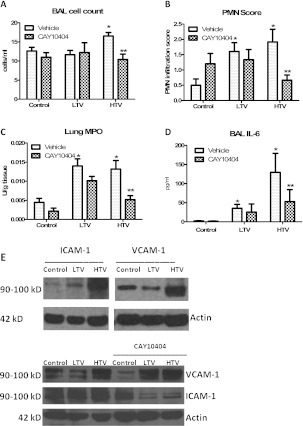Figure 2.
Mechanical ventilation induces lung inflammation. HTV ventilation induced a mild, but statistically significant, increase in alveolar leukocytes (A, light bars) that was significantly attenuated by the pharmacologic inhibition of COX-2 with CAY10404 (A, dark bars). Both LTV and HTV ventilation increased tissue polymorphonuclear leukocytes (PMNs) and tissue myeloperoxidase (MPO) activity compared with spontaneously breathing control mice (B and C, light bars), indicative of acute tissue inflammation. COX-2 inhibition with CAY10404 significantly decreased both tissue PMNs and tissue MPO activity in HTV mice, with a trend toward decreased MPO in control and LTV mice (B and C, dark bars). (D) Finally, mechanical ventilation induced a tidal volume–dependent increase in BAL IL-6, which was significantly attenuated in HTV mice treated with CAY10404. Lung homogenates were stained for ICAM-1 and VCAM-1 as representative inflammatory cell adhesion molecules. (Results were repeated in triplicate, and representative images are shown). (E, top left) Mechanical ventilation induced a stepwise increase in ICAM-1 expression compared with control mice. (E, top right) In contrast, whereas HTV ventilation increased VCAM-1 expression, LTV ventilation was associated with a decrease in VCAM-1 expression compared with control mice. (E, bottom) The pharmacologic inhibition of COX-2 significantly decreased ICAM-1 expression in both the LTV and HTV groups, but increased VCAM-1 in the LTV and HTV groups. LTV, low tidal volume ventilation; HTV, high tidal volume ventilation; BAL, bronchoalveolar lavage; ICAM-1, intercellular adhesion molecule–1; VCAM-1, vascular cell adhesion protein–1. *P < 0.05 versus control values. **P < 0.05 versus HTV alone.

